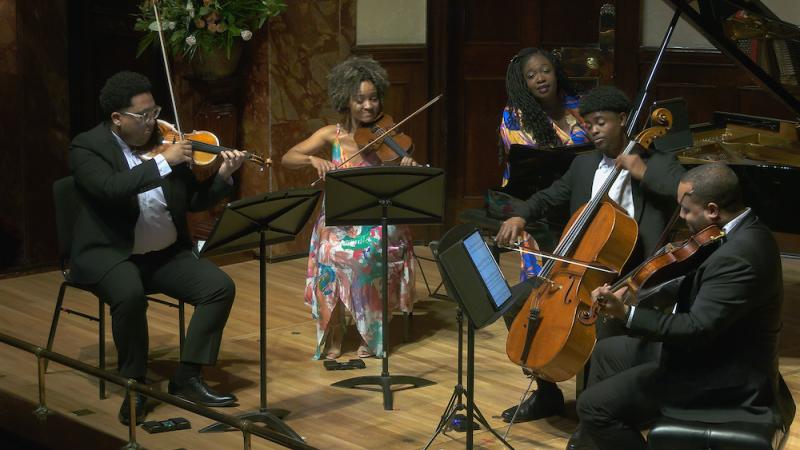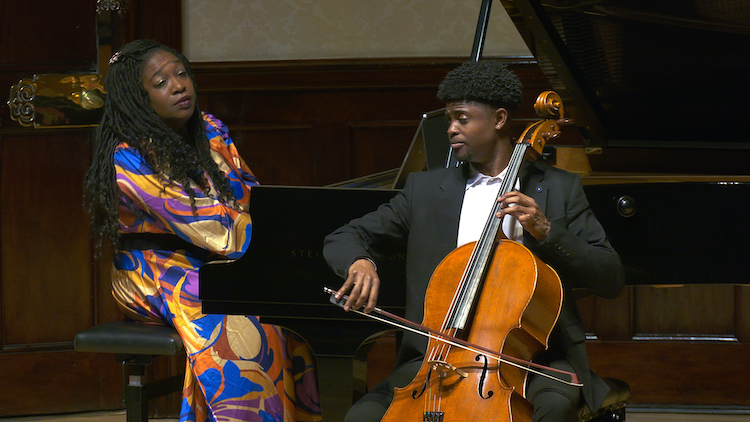Sphinx Organization, Wigmore Hall review - black performers and composers take centre stage | reviews, news & interviews
Sphinx Organization, Wigmore Hall review - black performers and composers take centre stage
Sphinx Organization, Wigmore Hall review - black performers and composers take centre stage
A welcome spotlight on diversified repertoire, played with sincerity and humour

Kudos to the Wigmore Hall for continuing to make efforts to diversify its roster of performers and repertoire. Last year I reviewed the Kaleidoscope Collective, and noted how the different profile of their players attracted a younger and less universally white audience to the hall, and the same happened again last night when the American Sphinx Organization were given the stage.
Sphinx is a Michigan-based, multi-faceted “social justice organization dedicated to transforming lives through the power of diversity in the arts” which embraces education, artist development and arts leadership. Yesterday’s concert was evidence of the success of their performing artists programme, focused on promoting the careers of black musicians playing the music of black composers.
Jessie Montgomery’s string quartet Strum was a fine opener. Starting with violist Michael Casimir playing guitar-style, it opened out into a complex texture of competing lines, with pizzicato a constant feature, now and then interrupted by warm chordal passages. The players, like the music, were busy, business-like and unsentimental.
Likewise with Tania Léon’s solo piano Tumbao, a tribute to the composer’s Cuban-American heritage. Played with extrovert abandon by Michelle Cann, I’d have liked it to have been longer, the virtuosic cross-rhythms and percussive cluster chords making for a very engaging experience. In fact, Cann’s enthusiastic, slightly breathless spoken introduction may have been longer than the actual piece, which is not really the right balance. Sentimentality was to the fore in William Grant Still’s cello and piano piece Mother and Child. If the Léon was too short that wasn’t a problem here. It was played nicely by Sterling Elliott (pictured above with Michelle Cann), whose generous tone and refusal to indulge in bathos I appreciated. But, to paraphrase Stravinsky, the piece was over well before it finished.
Sentimentality was to the fore in William Grant Still’s cello and piano piece Mother and Child. If the Léon was too short that wasn’t a problem here. It was played nicely by Sterling Elliott (pictured above with Michelle Cann), whose generous tone and refusal to indulge in bathos I appreciated. But, to paraphrase Stravinsky, the piece was over well before it finished.
Florence Price’s Piano Quintet in E minor, one of her pieces rediscovered only in the 21st century as a manuscript in her abandoned summer home, felt short-winded, perhaps because it is suspected there was another movement which remains lost. The first couple of minutes are the most interesting harmonically, after which it settles into Price’s familiar post-Romantic soundworld. The languorous dreaminess of the second movement was the best bit, violinist Alex Gonzalez finding a sweet sound amid the musical haze.
After the interval, a delightful arrangement of Take the “A” Train, Elliott on a lively walking bass, each player having a solo, jazz style. There was more than a hint of Stéphane Grappelli in Melissa White’s, and I found the whole thing charming.
But the most extraordinary piece of the night was Coleridge-Taylor Perkinson’s Movement for String Trio, written in 2004, the year he died. Before Saturday I had never heard of Perkinson, when a new album of his music was reviewed in theartsdesk’s CD column. Then on Sunday I heard this humble but wonderful piece, a kind of wonky Bach, the pizzicato bass of the “Air on the G string” distorted into something new and fascinating. Small but perfectly formed (and beautifully played) it is well worth seeking out online.
After which there was just the Piano Quintet by Samuel Coleridge-Taylor, Perkinson’s namesake. On the one hand this is an extraordinary achievement for an 18-year-old composer in 1893, a convincing, substantial piece of post-Brahms chamber music. But I am a bit of a Coleridge-Taylor sceptic, finding his late-19th century musical language a bit overwrought – especially in comparison to Perkinson’s restraint. Here the ensemble were not put off by a broken viola string – Michelle Cann filled the gap with a ragged-up version of Rachmaninov’s famous C-sharp-minor Prelude – and their evident joy in playing in the Wigmore Hall helped them to carry off what, for me, is a bit of clunky Victoriana.
rating
Explore topics
Share this article
The future of Arts Journalism
You can stop theartsdesk.com closing!
We urgently need financing to survive. Our fundraising drive has thus far raised £49,000 but we need to reach £100,000 or we will be forced to close. Please contribute here: https://gofund.me/c3f6033d
And if you can forward this information to anyone who might assist, we’d be grateful.

Subscribe to theartsdesk.com
Thank you for continuing to read our work on theartsdesk.com. For unlimited access to every article in its entirety, including our archive of more than 15,000 pieces, we're asking for £5 per month or £40 per year. We feel it's a very good deal, and hope you do too.
To take a subscription now simply click here.
And if you're looking for that extra gift for a friend or family member, why not treat them to a theartsdesk.com gift subscription?
more Classical music
 Bizet in 150th anniversary year: rich and rare French offerings from Palazzetto Bru Zane
Specialists in French romantic music unveil a treasure trove both live and on disc
Bizet in 150th anniversary year: rich and rare French offerings from Palazzetto Bru Zane
Specialists in French romantic music unveil a treasure trove both live and on disc
 Scottish Chamber Orchestra, Ibragimova, Queen’s Hall, Edinburgh review - rarities, novelties and drumrolls
A pity the SCO didn't pick a better showcase for a shining guest artist
Scottish Chamber Orchestra, Ibragimova, Queen’s Hall, Edinburgh review - rarities, novelties and drumrolls
A pity the SCO didn't pick a better showcase for a shining guest artist
 Kilsby, Parkes, Sinfonia of London, Wilson, Barbican review - string things zing and sing in expert hands
British masterpieces for strings plus other-worldly tenor and horn - and a muscular rarity
Kilsby, Parkes, Sinfonia of London, Wilson, Barbican review - string things zing and sing in expert hands
British masterpieces for strings plus other-worldly tenor and horn - and a muscular rarity
 From Historical to Hip-Hop, Classically Black Music Festival, Kings Place review - a cluster of impressive stars for the future
From quasi-Mozartian elegance to the gritty humour of a kitchen inspection
From Historical to Hip-Hop, Classically Black Music Festival, Kings Place review - a cluster of impressive stars for the future
From quasi-Mozartian elegance to the gritty humour of a kitchen inspection
 Shibe, LSO, Adès, Barbican review - gaudy and glorious new music alongside serene Sibelius
Adès’s passion makes persuasive case for the music he loves, both new and old
Shibe, LSO, Adès, Barbican review - gaudy and glorious new music alongside serene Sibelius
Adès’s passion makes persuasive case for the music he loves, both new and old
 Anja Mittermüller, Richard Fu, Wigmore Hall review - a glorious hall debut
The Austrian mezzo shines - at the age of 22
Anja Mittermüller, Richard Fu, Wigmore Hall review - a glorious hall debut
The Austrian mezzo shines - at the age of 22
 First Person: clarinettist Oliver Pashley on the new horizons of The Hermes Experiment's latest album
Compositions by members of this unusual quartet feature for the first time
First Person: clarinettist Oliver Pashley on the new horizons of The Hermes Experiment's latest album
Compositions by members of this unusual quartet feature for the first time
 Gesualdo Passione, Les Arts Florissants, Amala Dior Company, Barbican review - inspired collaboration excavates the music's humanity
At times it was like watching an anarchic religious procession
Gesualdo Passione, Les Arts Florissants, Amala Dior Company, Barbican review - inspired collaboration excavates the music's humanity
At times it was like watching an anarchic religious procession
 Classical CDs: Camels, concrete and cabaret
An influential American composer's 90th birthday box, plus British piano concertos and a father-and-son duo
Classical CDs: Camels, concrete and cabaret
An influential American composer's 90th birthday box, plus British piano concertos and a father-and-son duo
 Cockerham, Manchester Camerata, Sheen, Martin Harris Centre, Manchester review - re-enacting the dawn of modernism
Two UK premieres added to three miniatures from a seminal event of January 1914
Cockerham, Manchester Camerata, Sheen, Martin Harris Centre, Manchester review - re-enacting the dawn of modernism
Two UK premieres added to three miniatures from a seminal event of January 1914
 Kempf, Brno Philharmonic, Davies, Bridgewater Hall, Manchester review - European tradition meets American jazz
Bouncing Czechs enjoy their Gershwin and Brubeck alongside Janáček and Dvořák
Kempf, Brno Philharmonic, Davies, Bridgewater Hall, Manchester review - European tradition meets American jazz
Bouncing Czechs enjoy their Gershwin and Brubeck alongside Janáček and Dvořák
 Solomon, OAE, Butt, QEH review - daft Biblical whitewashing with great choruses
Even a top soprano and mezzo can’t make this Handel paean wholly convincing
Solomon, OAE, Butt, QEH review - daft Biblical whitewashing with great choruses
Even a top soprano and mezzo can’t make this Handel paean wholly convincing

Add comment